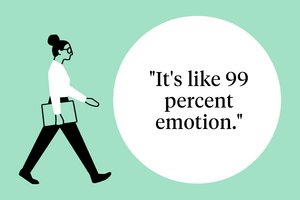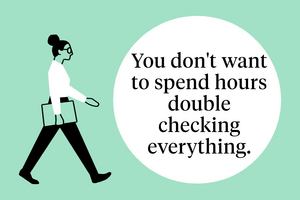Careers Dec 1, 2021
Mulling a Career Pivot? 3 Things to Consider
Knowing your own motivations can help you successfully transition to a new role or industry.

Lisa Röper
If something about your job doesn’t quite seem to fit your life or ambitions anymore, you are not alone. Around the world, employees are rethinking what they want and need at work.
Forty-one percent of the global workforce is likely to consider quitting their job this year, with 46 percent contemplating a “major pivot or career transition,” reports Microsoft. Meanwhile, half of American workers are considering a career change, reports CNBC—while in September, a record-breaking 4.4 million Americans—3 percent of the workforce— actually quit their jobs. The so-called “Great Resignation” shows no signs of stopping.
What’s going on?
“We’re in a moment in time that has staying power,” says Ellen Taaffe, a clinical assistant professor of management and organizations and director of Women’s Leadership Program at Kellogg.
COVID has had a huge impact on most of our daily lives. The pandemic has emphasized that life is short, and also that, for better or for worse, things once viewed as nonnegotiable or intractable—from in-person work and school to busy social calendars—now appear more up for debate. In short, employees are looking at the options available to them with new eyes. And, because companies have retooled everything from strategy to operations, they’re still evolving. Which means even more opportunities for employees. “You can stay and redesign, reinvent both yourself and your company, or you can create what you want somewhere else. COVID has accelerated all of this.”
Moreover, Taaffe says, thanks to the tight labor market, firms may be more receptive to giving employees what they seek. This makes now a great moment to consider a pivot, whether that is to a new function within your company, or to a new company or industry. “I think there’s no better time to take stock of what’s important to you, to imagine a new future, and to strategize in how to get there,” she says.
She explains how to get started.
Take Stock
To figure out your next move forward, you first need to look backwards. Before you delve into your search for a new role, set aside time to consider: What have you learned about yourself in the last two years?
Get concrete and specific, Taaffe advises. Make a list of answers for each question. Write them down.
For example, if you’re still working from home, what have you realized about your preferences? It could be that you’re more productive, love not having a commute, or are more collaborative with colleagues across geographies. Or maybe you found out that you prefer face-to-face sales calls because developing new leads is harder on Zoom. Perhaps you miss travel.
“A lot depends on where you are in your life stage,” Taaffe says. “Some people value flexibility where others may crave social interaction.”
For example, a recent survey reports that more than half of employees would like to work from home for three or more days per week, but that working parents with young children are more likely to prefer fully remote work.
“The power dynamic has changed. Employees have more leverage now. Companies are changing so much that they might be more open to something they rejected before.”
— Ellen Taaffe
You should also take stock of what you have learned about your industry and company. The pandemic drastically changed working conditions in industries such as healthcare and education. And many industries—like hospitality, travel, and retail—are trying to reinvent themselves altogether.
Within your company, look at its trajectory. For example, if the pandemic forced a wave of layoffs or a mass exodus, take note. Perhaps new business units are expanding headcount and can’t hire fast enough. How might you fit in?
“Consider the impact COVID has had on your company’s business model and which changes are temporary or likely to continue into the future. Assess how that may or may not affect future performance, your function, company leadership and resources, and the longer-term outlook for both growth and a satisfying work environment,” says Taaffe. “Do your responses to these questions tell you that it may be time to pivot?”
Imagine the Future
As companies figure out how to adapt and retain talent, now is a good time to brainstorm what is important to you. So be bold and imagine your ideal future job. Get actionable. “What do you want to do, drop, delegate, decline, or dare to do?” Taaffe asks.
Employees who have worked in a company for a while and are a known entity with social capital are especially well-positioned to negotiate new or expanded roles within their organizations.
“Companies are losing talented individuals, and they’re worried about it,” Taaffe says. “So if you take stock in the company and think, “We have a chance to grow, I’m still developing here, and I can make a difference,” you should consider staying.”
But of course, just because you want something doesn’t mean you’ll get it. Whether your current company won’t make the necessary changes or whether they simply can’t, it may be time to look elsewhere. “You owe it to yourself to look and to understand your options,” says Taaffe.
And don’t rule out opportunities or working arrangements that were a no-go in prior years.
“The power dynamic has changed. Employees have more leverage now,” Taaffe says. “Companies are changing so much that they might be more open to something they rejected before.”
As you explore opportunities, you will need to translate your wants and needs in ways that are beneficial to the company that is considering you. As companies’ value propositions for employees evolve, you should position your priorities as part of their solution, she says.
“Be prepared to explain, ‘Here’s what I’m really good at, this is what I want to do that can add value, and here’s how we can shape it,’” she says. “For example, if you are interviewing to lead a major initiative, now is the time to negotiate for how you want to lead it. This could mean focusing on your strengths: your strategy, your ability to achieve cross-functional alignment, and your skill at communicating to senior management. Then let them know that leading the initiative well requires a strong project manager. Then ask for what you need to succeed.”
Find Where You Want to Be
Finally, it’s time to investigate if a company’s values match yours.
Taaffe notes that even prior to the pandemic, the Me Too and BLM movements cast a spotlight on the dissonance between what companies say they value and their actions. The pandemic has only increased the pressure on companies to walk the talk on key issues like racial and gender equality or climate change. Employees, especially underrepresented minorities, Generation Z, and Millennials, are fed up with companies whose ethics do not carry through to daily operations.
So interested employees should seize this moment to find a role or organization that is consistent with the impact they want to have on the world. “Ask yourself whether the values you have match the values of this company,” Taaffe says. “How do they show up in behaviors and not simply signs in the lobby?”
While you are zeroing in on the type of work you want to be doing—and the right company to do it—don’t forget to prioritize your own well-being. In the wake of the pandemic, employee mental-health issues are escalating. With lots of employees feeling anxious, isolated, or burnt out—or grieving lost loved ones—it is important to consider whether employee mental health and well-being is a priority at these companies. What do they offer for support?
And while it is good to inquire about the benefits package, it helps to realize that a company’s stance on mental health extends beyond benefits. “Find out whether the company recognizes what people have been through,” Taaffe recommends.
Just as many companies put policies in place for physical safety—from COVID protocols to fire drills—employees also want psychological safety, Taaffe says. Leaders can best create this by being authentic, humble, and inclusive themselves and expecting this as the norm across their company. This allows employees to feel safe, take risks, and think in more innovative ways.
“A silver lining of the pandemic is that we got a bigger window into our colleagues,” Taaffe says, “whether that was seeing their make-shift office at the kitchen table, their kids or pets, or the anxiety and uncertainty we all feel about the future. We learned that it’s okay to not be okay.”
Part of taking stock is asking whether this cultural shift holds true in a company.
Taaffe recommends that, as you meet people through the interview process, ask the same questions to each person about the culture, the leadership, and their outlook on work-from-home, hybrid, or in-office expectations. Then consider the refrains you may hear in those responses—especially those that reveal more than a robotic company message.
“Listen for vulnerability and transparency as they talk about the challenges the company has been through over the last two years,” she says. “No company had all of the answers, especially in the pandemic. If they respond like they do, you know you aren’t talking to a learning organization where it is safe to say, ‘I don’t know.’”
She suggests asking about how the company handled failures or mistakes. Does the organization debrief on what worked and what insights it can apply next time? What happens to those who were involved with a failed initiative or product launch?
“You can tell that psychological safety is strong when employees can bring their whole selves to work,” Taaffe says. “If the company combines diversity of styles and approaches with consistency of their values and work ethic, you may have found the right place for you to thrive.”



